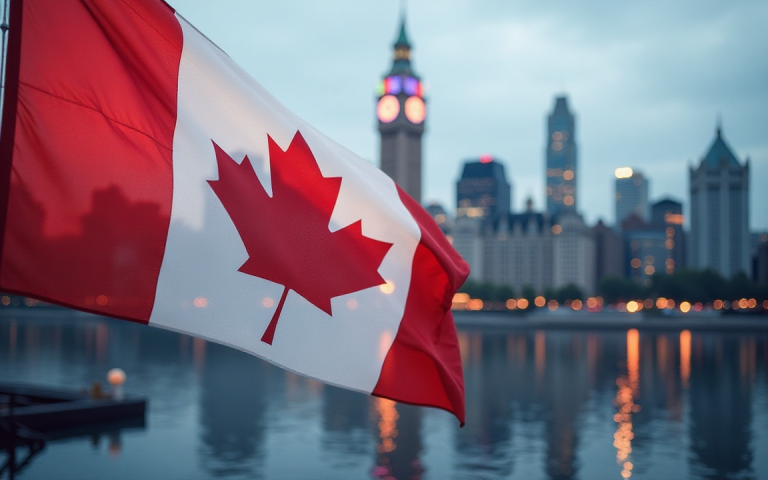Canada’s election had little to do with foreign policy initially.
But when Canadians went to the polls earlier this week, it was the actions of the US President that decided the future of their country, for the most part at least.
What began as a referendum on rising living costs and political fatigue became a vote for sovereignty itself.
Now, with Mark Carney leading the Liberal Party to a victory, Canada’s economy finds itself in a critical position.
The new Prime Minister has many issues to address, but most importantly, the people of Canada want to feel assured that their leader is the right one to lead them through the current uncertainty and chaos.
Why Trump’s trade war turned the election upside down
Until early 2025, the Canadian Liberals looked finished.
Inflation was rising, housing affordability was collapsing, and Justin Trudeau’s government appeared exhausted after nearly a decade in power.
Conservative leader Pierre Poilievre led the polls comfortably.
But the situation changed rapidly, when President Trump escalated his threats against Canada. New tariffs were announced on Canadian autos, steel, and aluminum.
Trump even revived talk about turning Canada into the 51st state.
The combination of economic pain and national insult triggered a wave of nationalism across Canada, and this time, not in favor of the conservative party.
Mark Carney used Trump’s provocations to reframe the election.
He warned that Trump wanted to break Canada economically to force political control.
His message shifted the public debate from domestic dissatisfaction to an existential crisis. Poilievre on the other hand focused mainly on cost-of-living issues and failed to adapt to the new reality.
In the final weeks, the campaign became less about Trudeau’s legacy or Poilievre’s promises and more about resisting foreign pressure.
A record 7.3 million Canadians voted early, many motivated by anger at Trump’s rhetoric.
The Liberals rode this backlash to victory, leaving the Conservatives with another frustrating defeat despite gaining more seats and votes than in previous elections.
Mark Carney’s rise and what it means for Canada’s economy
Mark Carney’s political career barely existed before this year.
A former central banker, he had never held elected office before becoming prime minister.
Yet he was uniquely positioned to lead at a time when Canadians craved competence over charisma.
Carney’s background at the Bank of Canada, the Bank of England, and Goldman Sachs gave him instant credibility on economic issues.
He portrayed himself not as a career politician but as a defender of Canada’s financial independence. In a chaotic global environment, his technocratic image resonated deeply with voters.
Carney also moved quickly to separate himself from unpopular Trudeau-era policies.
He scrapped a proposed capital gains tax increase, lifted the consumer carbon tax, and promised a focus on productivity and energy exports.
His campaign was less about new promises and more about providing the sense that he could hold the country together under pressure.
And it worked. Carney’s ability to turn a technocrat’s CV into a nationalist campaign set a new model for Canadian leadership.
It also indicated that the country’s next phase would not be business as usual. It would be one of bigger adjustments.
How Canada’s economy must change
Canada sends about 75% of its exports to the United States.
Under normal circumstances, that level of economic integration would be a strength. But under a hostile US administration, it is a dangerous vulnerability.
In his victory speech, Carney has already acknowledged that the economic relationship Canada relied on for decades is over, saying:
“We are over the shock of the American betrayal, but we should never forget the lessons. […] President Trump is trying to break us so America can own us. That will never happen.”
Negotiations on a new economic and security agreement with Washington are expected to begin immediately, but expectations are low. Trump’s tariff policies are unlikely to change for now.
Instead, Carney has outlined a strategy to build resilience.
His government plans to invest C$5 billion into a trade diversification fund to develop new export markets. Europe and Commonwealth countries are the most likely targets.
There is also a push to rebuild Canadian industrial capacity, particularly in auto manufacturing and critical minerals.
Carney’s vision includes an “all-in-Canada” model for vehicle production, using domestic steel, aluminum, and parts.
Although details are still vague, the goal is clear: reduce reliance on US supply chains as fast as possible.
Canada’s natural resource sector, particularly in Ontario and Alberta, will become central to both economic security and geopolitical leverage.
The Liberals are also promising a streamlined approval process for key energy and mining projects.
Carney wants Canada to become a clean and conventional energy superpower, exporting not only oil and gas but also the raw materials needed for electric vehicles and aerospace manufacturing.
What political risks could derail this plan
Winning the election was only the first step. Implementing the plan will be much harder, especially if the Liberals do not secure a majority in Parliament.
If forced to govern with a minority, Carney will need cooperation from smaller parties.
The New Democrats have collapsed, securing just 5% of the national vote, and their leader Jagmeet Singh has stepped down.
The Bloc Québécois maintained some strength but remains a separatist force focused on Quebec’s interests.
Meanwhile, Western provinces like Alberta and Saskatchewan are already bristling under another Liberal term.
There is talk of secession referendums.
These provinces control much of Canada’s energy and critical minerals, making their discontent more dangerous than it would have been in previous decades.
Carney must balance his green transition promises with genuine outreach to resource-rich provinces.
Some insiders suggest he might cancel Trudeau’s oil and gas emissions cap to ease tensions.
Others advocate appointing conservative figures to diplomatic roles to project national unity.
Failure to manage this internal division could fracture Canada’s ability to present a unified front in trade and security negotiations. That would weaken everything Carney is trying to achieve.
Will Canada rethink capitalism itself?
There is also a deeper economic conversation beginning under the surface.
The experience of the trade war and the risks of globalization have renewed interest in employee-owned businesses and cooperative models.
New federal legislation passed last year introduced Employee Ownership Trusts, making it easier for firms to transfer ownership to workers.
Advocates argue that democratic firms are more resilient during economic shocks and less likely to move jobs offshore.
Some economists believe that Canada could protect itself from future external pressures by encouraging a broader shift to worker ownership models.
It would not just be about economic nationalism but about embedding control of assets directly into Canadian communities.
Although this idea remains peripheral for now, it fits with the new era of strategic thinking that the Carney government seems ready to embrace.
Overall, Canada’s economy is entering a new era as the time of easy assumptions about US friendship is over.
Canada’s path now must be built on diversification, resilience, and a reassertion of sovereignty at every level of policy.
The work will not be easy. It will not be quick. But for the first time in decades, Canada is being forced to think not just about prosperity, but about survival.
The post Canada’s election results are proof that Trump’s policies are not working: what’s next for the new Prime Minister? appeared first on Invezz










